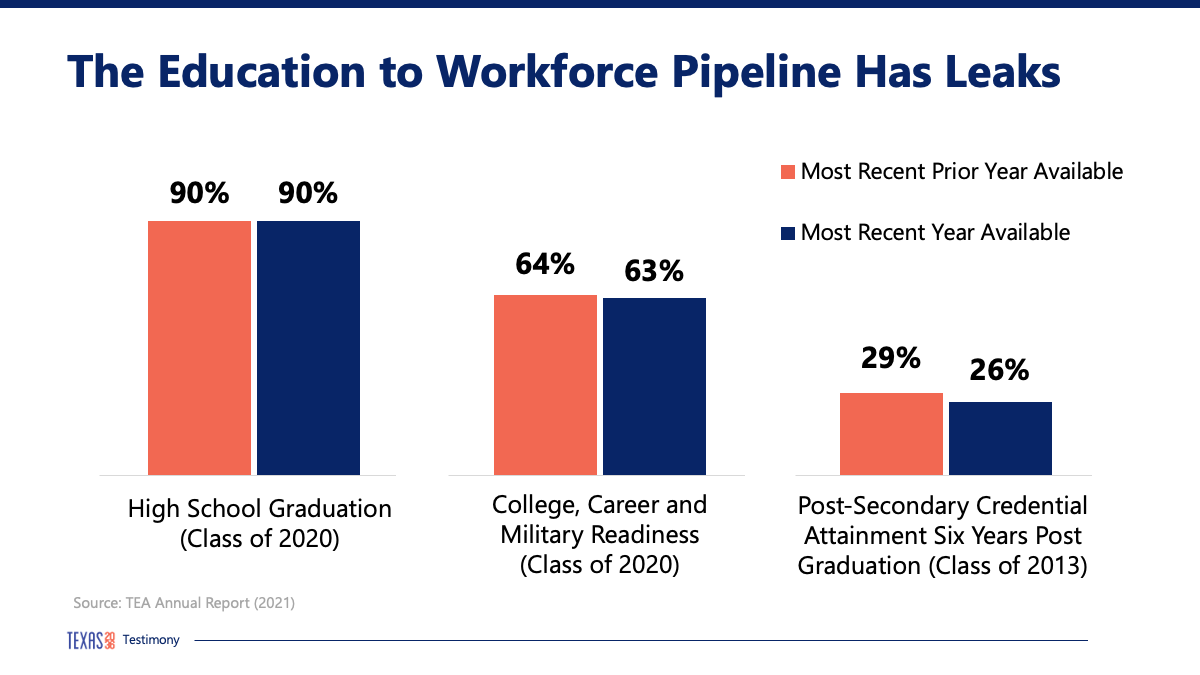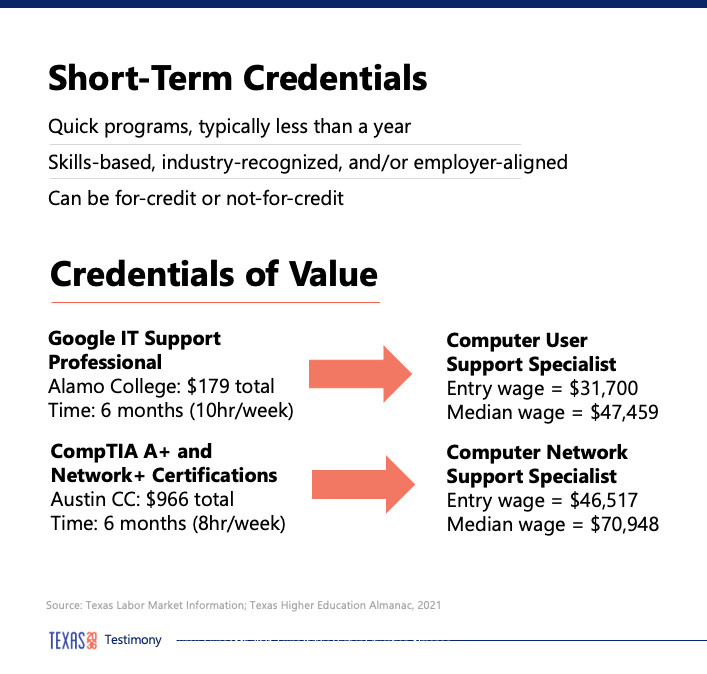The following is written testimony by Texas 2036 Policy Advisor Madison Yandell, which was delivered to the House Public Education Committee on July 26, 2022.
What to Know:
- Texas students are not earning the postsecondary credentials needed to meet Texas’ workforce demands and earn a self-sufficient wage.
- More students should graduate high school with workforce training and credentials that allow them to immediately pursue good-paying jobs, even if they plan to go to college.
- Virtual education should be leveraged to make career-aligned coursework and training more accessible, particularly in rural communities.
1. Texas students are not earning the postsecondary credentials needed to meet Texas’ workforce demands and earn a self-sufficient wage.
While Texas has steadily improved its high school completion rate over the last two decades with 90% of students now graduating in four years, a high school diploma is not the finish line it once was. As recently as 2011, more than half of all jobs in Texas that paid $65,000 or more per year were held by Texans with a high school diploma, GED, or below. By 2019, only 11% of high-paying jobs were held by Texans with a high school diploma, GED, or below.
 However, just over 60% of students are graduating college or career ready and less than 30% are attaining a postsecondary credential within six years of high school graduation. These leaks in the workforce pipeline have consequences: Texas ranks last among peer states in postsecondary credential attainment.
However, just over 60% of students are graduating college or career ready and less than 30% are attaining a postsecondary credential within six years of high school graduation. These leaks in the workforce pipeline have consequences: Texas ranks last among peer states in postsecondary credential attainment.
While the data shows we need more postsecondary education to meet our state’s workforce needs, Texas’ four-year university enrollment has plateaued. And during the pandemic, Texas community colleges have seen a nearly 15% drop in enrollment, equivalent to a loss of about 225k students. Particularly concerning from a workforce perspective is the decline in continuing education and technical college enrollment.
2. More students should graduate high school with workforce training and credentials that allow them to immediately pursue good-paying jobs, even if they plan to go to college.
Last session Senator Paul Bettencourt and Representative Jim Murphy passed an important bill – HB 3767 – also called the “Texas Education and Workforce Alignment Act.” This bill codified the Tri-Agency Workforce Initiative and required these agencies to adopt unified workforce goals and unified strategies to achieve them. A key element of this alignment is that all three agencies should be aiming to achieve the workforce goals regardless of where a student is in the pipeline. That means Texas Education Agency, Texas Higher Education Coordinating Board and Texas Workforce Commission can accomplish their unified goals when students hit career benchmarks in high school – and all the agencies can work toward those common aims.
Previously called 60x30TX, the new Building a Talent Strong Texas plan expands our state’s 60×30 goal to all post-secondary credentials available to students in Texas with emphasis on credentials of value, which are those that have a proven, positive economic return for students.
Since a high school diploma is no longer enough, we need to be exploring ways to get more career training into high schools, so all students are ready for future, family-sustaining jobs – regardless of whether they choose to attend college or not. Students should leave high school ready for the workforce on Day 1, but this is not currently the case for far too many students.
 Nearly 360,000 students graduated high school in Texas in 2021, but only 14% received an industry-based credential or Level I/II certificate in high school. In 2018, the most recent year for which data is available, 58% of graduates enrolled in college within one year.
Nearly 360,000 students graduated high school in Texas in 2021, but only 14% received an industry-based credential or Level I/II certificate in high school. In 2018, the most recent year for which data is available, 58% of graduates enrolled in college within one year.
Short-term credentials offer the opportunity to dramatically increase the number of Texans with workforce training that immediately leads to good-paying jobs without the need for a two- or four-year degree.
Some Texas community colleges are already offering short-term credential opportunities at low costs with great early results. As part of HB 3767, the state is building a credential library to better track options and outcomes allowing schools to tailor programs to their communities.
Credentials are not the only option. There are other workforce training programs that can be embedded into high school — such as apprenticeships — that prepare students for in-demand jobs. Currently, Texas lags behind in offering apprenticeships, a method of skills development valued by employers.
Indiana, California, and Washington have over three times Texas’ rate of apprentices in their workforce.
3. Virtual education should be leveraged to make career-aligned coursework and training more accessible, particularly in rural communities.
Texas should find ways to efficiently get students workforce training while they are in high school. Over the last few years, the state has made massive investments in the technologies needed for virtual education, which provides the opportunity to overcome barriers in access to apprenticeships, career and technical education, credentials of values, and the advanced coursework critical for high-demand occupations.
Many short-term credentials can be offered virtually and finished entirely in high school allowing students to graduate immediately ready for good jobs. This is an area ripe for collaboration between high schools and community colleges. Simulated workplaces and virtual reality can fill gaps where there may not be enough capacity for students to get the required hands-on training for certifications and apprenticeships.
Virtual education can and should be utilized to allow students to take courses they may not otherwise have access to due to where they live. Huge gaps in course offerings exist depending on where a student lives in the state. For example, suburban and urban students generally have access to 4-5x more AP courses than their peers in rural Texas. Frequently, these courses aren’t offered at many smaller schools due to economies of scale or the inability to hire teachers.
Similar issues inhibit access to CTE courses. The lack of trained and certified teachers in high-demand fields like computer science and robotics are long-term issues the state must solve for, but today’s students must have access as well. With modifications to address current barriers like teacher of record rules, virtual education can provide immediate access to high-value coursework for students across the state at a much lower cost to districts.
The pandemic’s staggering effect on education is well-documented but cannot be overstated. The situation is particularly vexing for high school students with only a few years to catch up before they pursue college or career options. The Committee’s examination of career readiness should consider the role virtual education can play in increasing access to proven strategies for workforce preparation.
Virtual education is not a silver bullet for the state’s workforce problem, but it is one of many strategies that can be deployed to put students on a path to a productive life after graduation.
